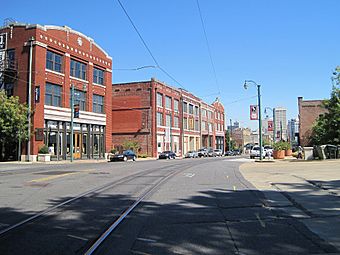South Main Street Historic District (Memphis, Tennessee) facts for kids
|
South Street Historic District
|
|

South Main, looking north from Longshot, in 2010
|
|
| Lua error in Module:Location_map at line 420: attempt to index field 'wikibase' (a nil value). | |
| Location | Roughly S. Main St. between Webster and Dr. Martin Luther King Junior Avenues, and Mulberry between Calhoun and Vance Avenues, Memphis, Tennessee |
|---|---|
| Area | 20 acres (8.1 ha) |
| Architect | Multiple |
| NRHP reference No. | 82004054 (original) 97000224 (increase 1) 99000756 (increase 2) 13000503 (increase 3) |
Quick facts for kids Significant dates |
|
| Added to NRHP | September 2, 1982 |
| Boundary increases | March 8, 1997 July 9, 1998 August 13, 2013 |
The South Main Street Historic District in Memphis, Tennessee, is a cool old part of the city. It's south of downtown and has over 100 buildings, mostly shops and businesses, spread across 11 blocks. These buildings were built between 1900 and 1930. They show off many different building styles from that time, like Beaux Arts, Georgian Revival, Art Deco, and Chicago Commercial.
This area was added to the National Register of Historic Places in 1982. It's important because it shows how much railroads helped Memphis grow before the Great Depression. The district also includes the Lorraine Motel, built in 1925. This is where Martin Luther King Jr. was sadly killed in 1968. A smaller area inside this historic district is called the South Main Arts District. The city of Memphis also calls this a local historic district.
Contents
Railroad History in South Main
The first train station in this area was on Calhoun Street, built around 1855. It was for the Mississippi and Tennessee Railroad. Later, a new station was built in its place. This second station was torn down to make way for Memphis Central Station.
Central Station was built between 1912 and 1914. It was a major hub for trains, especially those traveling north and south. Another important station, Memphis Union Station, was built nearby around the same time. Union Station mainly handled trains going east and west.
What the District Looked Like
When the South Main Street Historic District was first added to the National Register in 1982, it had 105 buildings and a few empty lots. Most of these buildings were important to the area's history and look. Only a few were considered "non-contributing" because they had been changed too much or didn't fit in.
The district covers South Main Street between Linden and Webster. It also includes Mulberry Street, which runs next to Main, between Vance and Butler. Some buildings on other streets like Butler, Calhoun, Huling, Pontotoc, and Vance are also part of the district. Most buildings are one to three stories tall, but a few are taller.
Almost all the buildings are made of brick, terra-cotta, or cast stone. Many buildings on South Main Street were built right at the edge of the sidewalk. The only grassy areas are at the fire station and one hotel, which are set back from the street.
The most famous building is Memphis Central Station, which opened in 1916. Many other buildings in the district were built to serve train travelers. These included hotels, restaurants, and bars. There were also businesses that made heavy goods that were shipped by train. These businesses chose to be near the station to save money on transportation. This area used to be a fancy neighborhood, but most homes were replaced by businesses. A few large houses stayed and became hotels.
Growing the Historic District
Over the years, the historic district has grown to include more important buildings.
- In 1997, the 1914 Railway Express Agency Building was added. This building at 663 S. Main St. was important for handling freight (goods shipped by train).
- In 1999, two identical buildings at 384 Mulberry and 129 Talbot were added. These were built around 1905 as homes for African-American families.
- In 2013, several more buildings on G.E. Patterson Ave. and St. Paul Ave. were added. These were also important for handling freight and showed the area's rail history.
Bringing South Main Back to Life
After World War II, the rail industry slowed down, and the South Main area became less busy. It became well-known after the sad event at the Lorraine Motel.
More recently, the area has become popular again. Old historic buildings now house trendy restaurants, bars, and shops. In 2017, there were plans to turn Memphis Central Station into a unique hotel. The station's old powerhouse building was even turned into a movie theater in 2019. The city of Memphis has also offered tax breaks to encourage more new projects in the area.
The National Civil Rights Museum, which used to be the Lorraine Motel, opened in 1991. The Orpheum Theatre, just outside the district, is also a historic place listed on the National Register.

